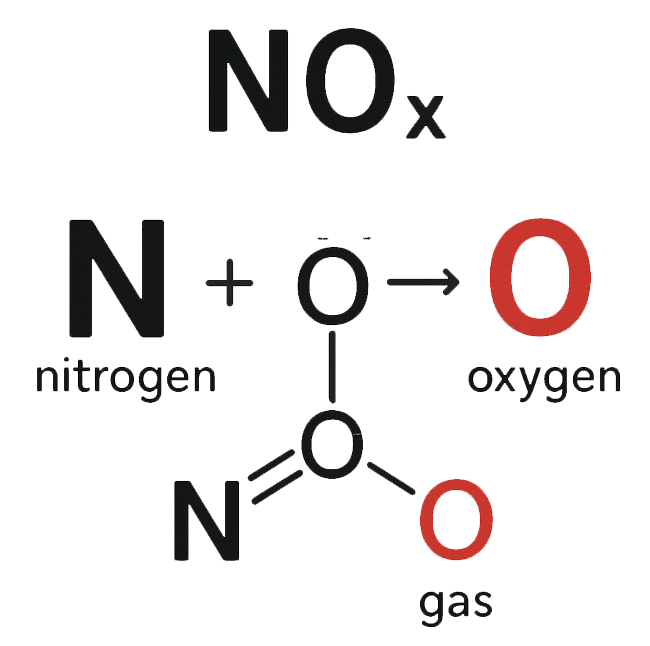In our increasingly urbanized and industrialized world, air pollution has become an everyday concern. While most people are familiar with terms like carbon emissions and smog, fewer understand the role of NOx Gas—a major contributor to poor air quality, acid rain, and even climate change. Though invisible, NOx gases have a powerful presence in our atmosphere, our lungs, and our policies. This blog explores what NOx Gases are, where they come from, and why they're considered a serious threat.
What Is NOx Gas?
NOx refers to Nitrogen Oxides, a family of reactive gases formed by the combination of Nitrogen (N) and Oxygen (O). The two primary members of this group are:
- Nitric Oxide (NO): A colorless gas that is not directly harmful in low concentrations but reacts quickly with oxygen to form more toxic gases.
- Nitrogen Dioxide (NO2): A reddish-brown gas with a strong odor, known for causing respiratory issues and contributing to ground-level Ozone and smog.
Together, these gases are commonly called NOx in environmental science and regulation. They are primarily produced during high-temperature combustion processes, especially those involving fossil fuels.
While NO and NO2 dominate, other forms of Nitrogen Oxides can also be found in specific conditions.
- Nitric Oxide (NO) – Formed directly during combustion.
- Nitrogen Dioxide (NO2) – Created when NO reacts with oxygen in the air.
- Nitrous Oxide (N2O) – Often used as an anesthetic, but also a potent greenhouse gas.
- Dinitrogen Trioxide (N2O3) – Less common, but forms under specific atmospheric conditions.
- Dinitrogen Tetroxide (N2O4) – A dimer of NO2, important in some industrial reactions.
Although not all of these gases are equally harmful in ambient air, NO2 is the most closely monitored, especially in urban environments.
Where Does NOx Come From?
The largest sources of NOx Gas are human-made, primarily tied to energy production, transportation, and industrial activity. High-temperature combustion processes are the main culprits, with diesel and gasoline vehicle engines emitting substantial amounts of NOx, especially under load. Power plants, particularly those burning coal or natural gas, are also significant contributors. In addition, industrial boilers and furnaces used in manufacturing, refining, and steel production generate large quantities of NOx. Aircraft and ships emit high levels as well, especially during takeoff, landing, or heavy load conditions. While natural sources like lightning strikes and wildfires do produce some NOx, their contribution is relatively minor compared to the scale of emissions caused by human activity.

NOx Gas Environmental Effects
Once released into the atmosphere, NOx Gases set off a chain reaction of harmful environmental effects. When NO2 interacts with sunlight and other atmospheric compounds, it contributes to the formation of ground-level ozone—a major component of urban smog. Ozone may be protective in the upper atmosphere, but at ground level, it's harmful to humans, plants, and animals.
Additionally, NOx reacts with water vapor to form acid rain. This acidified precipitation damages forests, soils, and bodies of water, altering ecosystems and reducing biodiversity. NOx also contributes to nutrient pollution in coastal waters, causing algal blooms that harm aquatic life.
Health Impacts of NOx Exposure
Prolonged or repeated exposure to Nitrogen Oxides—especially NO2—can have serious health effects, particularly for vulnerable groups like children, the elderly, and people with preexisting respiratory conditions. Key health risks include:
- Aggravation of asthma symptoms
- Increased risk of respiratory infections
- Chronic lung disease development
- Reduced lung function over time
- Irritation of the eyes, nose, and throat
Monitoring indoor and outdoor NOx levels with a gas monitor can be crucial in occupational or high-traffic environments. Accurate data helps prevent overexposure and ensures air quality remains within safe limits.
While NOx Gases are not the primary greenhouse gases like CO2 or CH4 (Methane), they play an important indirect role in climate forcing. NOx influences atmospheric chemistry by contributing to the formation of Ozone, a greenhouse gas at low altitudes, altering the lifespan of Methane by accelerating its breakdown, and forming aerosols that affect cloud formation and radiation balance. These interactions make NOx both a local air quality issue and a global climate concern. To address these impacts, governments and industries have developed several strategies to reduce NOx emissions from major sources.
Recognizing the harmful effects of NOx, many countries have enacted strict air quality standards. For example, the Environmental Protection Agency (EPA) in the United States regulates NO2 under the Clean Air Act, while Europe’s Euro Emission Standards have significantly lowered allowable NOx emissions from vehicles. Developing countries are also beginning to adopt stricter guidelines as urbanization accelerates air pollution challenges. Efforts to harmonize global NOx limits continue, with organizations like the World Health Organization (WHO) providing health-based guidance levels to protect public health.
NOx Gas Detection and Monitoring
Detecting and measuring NOx is essential for compliance, health, and safety. Advanced gas detection technologies have made this easier and more accurate. The GasDog gas detector and monitor are examples of modern, reliable tools used in industrial, environmental, and research settings. These devices can:
- Provide real-time NOx concentration readings
- Alert users when levels exceed safe thresholds
- Integrate with larger building or factory automation systems
- Log data for compliance and reporting purposes
To meet diverse monitoring needs, GasDog offers three types of NOx gas detectors:
- GD200 Portable NOx Gas Detector
- GD300 Fixed Online NOx Gas Detector
- GD700 Wall-mounted NOx Gas Detector
Each model is designed to deliver precise and dependable detection for a variety of applications. As more cities and industries push for clean air and sustainable operations, the demand for smart gas detection tools like these continues to grow.
In summary, NOx Gas—though unseen—plays a significant role in affecting both the environment and public health. Recognising its sources and impacts is essential, as is the use of effective monitoring tools like the GasDog gas detection equipment to keep track of its presence. With careful management and ongoing vigilance, we can better control NOx emissions and help ensure cleaner air for all.

